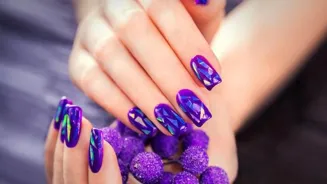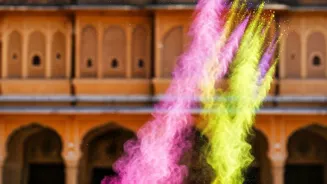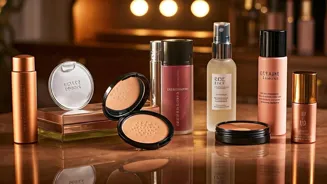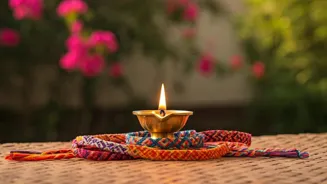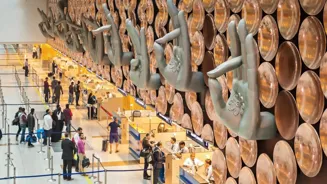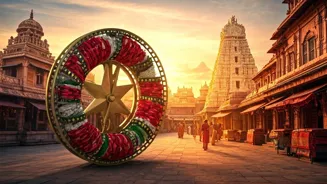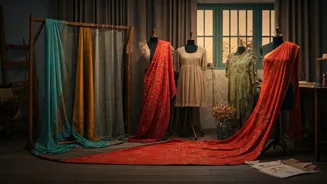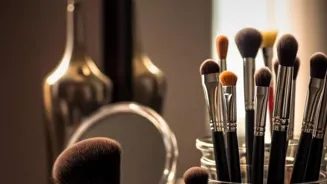Unveiling the Evolution of Nail Art: A Journey from Tradition to Trend. Dive into the history and global impact of nail art
From the basic application of nail polish to elaborate 3D designs, nail art has
undergone a massive transformation in recent years. What was once considered a simple grooming ritual is now a form of creative expression, with trends evolving quickly and techniques becoming increasingly sophisticated.
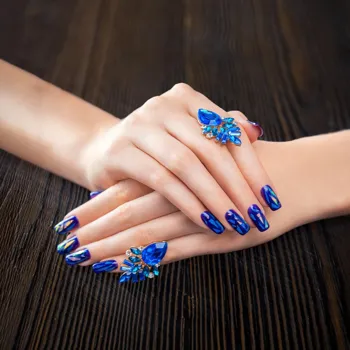
Nail art's global rise fueled by social media, embraced by Indian women
Nail art's popularity isn't just some flash-in-the-pan. Social media's impact is undeniable, with platforms like Instagram and Pinterest showcasing amazing designs from artists worldwide.
Indian women, in particular, have wholeheartedly embraced nail art, incorporating it into festive celebrations, weddings, and everyday fashion statements.
Nail art's ancient roots link to power and status symbols
The story of nail art begins much further back than you might think. Evidence suggests that nail decoration dates back thousands of years. Ancient civilizations like the Egyptians and Chinese used natural dyes to stain their nails, signifying social status rather than simply for attractiveness.
In fact, in ancient Egypt, Cleopatra herself was known to favor a deep red hue for her nails. Interestingly, the color of the nails often indicated one's position in society. The higher the rank, the bolder and darker the color was.
This practice was not merely about aesthetics; it was a visual representation of power and authority. These early forms of nail coloring were typically derived from plant extracts, henna, and other natural sources.
While the techniques were rudimentary compared to modern nail art, the underlying principle – using nails as a canvas for self-expression – remains consistent. The tools were also quite basic, focusing on application rather than intricate design.
Manicure evolution from basic care to vibrant nail art
The concept of a manicure, as we understand it today, started gaining traction in the 19th century. With the invention of new tools and techniques, nail care moved from a simple routine to a more formalized process.
Early manicures involved shaping, buffing, and polishing the nails using basic implements. The polish itself remained fairly simple – usually a tinted paste or cream providing a natural sheen.
The focus was still primarily on hygiene and maintaining healthy nails rather than on creating complex designs. However, this era set the groundwork for future advancements by establishing nail care as an important aspect of personal grooming.
As the 20th century dawned, the development of new chemicals and materials allowed for more durable and vibrant nail polishes, paving the way for the birth of true nail art.
This period represents a crucial bridge between the ancient practices of nail staining and the modern, expressive art form we know today.
The birth of modern nail polish revolutionized nail art evolution
The early 20th century witnessed the birth of modern nail polish, a pivotal moment in the evolution of nail art. The introduction of liquid nail polish, inspired by automobile paint, revolutionized the industry.
This new product offered a smoother, more durable finish compared to the traditional pastes and creams, and it came in a wider range of colors. This innovation quickly gained popularity, making manicured nails accessible to a broader audience.
As nail polish became more mainstream, women started experimenting with simple designs, like applying different colors to create stripes or dots. The introduction of the nail stencil further simplified this process, allowing for precise and repeatable patterns.
These early forms of nail art were relatively simple, but they marked a significant shift from basic manicures to using nails as a canvas for creative expression.
Salons began offering specialized manicures featuring these basic designs, contributing to the growing demand for more elaborate nail treatments. This period represents a crucial turning point, where nail care transitioned from mere hygiene to a form of fashionable self-expression.
Mid-20th century nail art innovations democratized creativity
The mid-20th century saw a boom in creativity and innovation in nail art techniques. The development of acrylic nails allowed for greater length and durability, creating a larger canvas for artists to work on. Airbrushing techniques emerged, enabling the creation of intricate gradients and patterns.
Nail stickers and decals became popular, offering a quick and easy way to add detailed designs without the need for advanced skills. These advancements democratized nail art, making it accessible to both professional artists and home enthusiasts.
Magazines and beauty publications started featuring nail art designs, further fueling the trend. Salons expanded their services to include more specialized nail art treatments, attracting a wider clientele.
This period was characterized by a spirit of experimentation and a growing recognition of nail art as a legitimate art form. The increasing availability of tools and tutorials empowered individuals to explore their creativity and express themselves through their nails.
The internet transformed Indian nail art with global trends & local motifs
The advent of the internet and social media platforms has been a game-changer for the nail art community. Instagram, Pinterest, and YouTube have become hubs for nail art enthusiasts, where artists share their creations, tutorials, and tips.
This global platform has allowed trends to spread like wildfire, with designs originating in one corner of the world quickly adopted in another.
Indian nail art has been heavily influenced by international trends, while also incorporating traditional motifs and designs specific to the Indian culture. From intricate henna-inspired patterns to Bollywood-themed designs, Indian nail art showcases a unique blend of global and local influences.
The digital age has also fostered a sense of community among nail artists, allowing them to connect, collaborate, and inspire each other. Online retailers offer a vast array of nail art supplies, making it easier than ever to access the tools and materials needed to create stunning designs.
Nail art trends: innovation, accessibility, self-expression, tech advances
The current nail art landscape is characterized by innovation and accessibility. Gel polish, known for its durability and shine, has become a staple in nail salons and home kits. 3D nail art, featuring embellishments like beads, rhinestones, and charms, adds a tactile dimension to designs.
The use of stencils, stamps, and freehand painting techniques allows for the creation of increasingly complex and personalized designs. Nail art is no longer limited to special occasions; it has become an everyday form of self-expression.
The rise of at-home nail art kits and online tutorials has made it easier than ever for individuals to experiment with different styles and techniques. The emphasis is on creativity and personalization, with individuals tailoring their nail art to reflect their personality and style.
As technology continues to evolve, we can expect even more exciting innovations in the world of nail art. From smart polishes that change color with mood to augmented reality apps that allow you to preview designs on your nails, the possibilities are limitless.
AI Generated Content. Glance/InMobi shall have no liability for the content